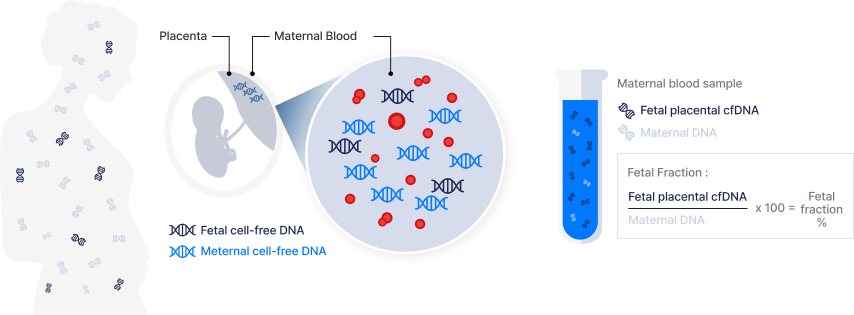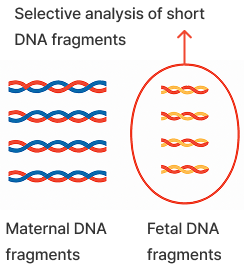TECHNOLOGY


 Fetal DNA fraction increased by up to 846%
Fetal DNA fraction increased by up to 846%
 Improved test success rate
Improved test success rate
 Higher accuracy and positive predictive value compared to conventional testing
Higher accuracy and positive predictive value compared to conventional testing
 Enhanced potential for early detection of rare abnormalities
Enhanced potential for early detection of rare abnormalities
The accuracy of non-invasive prenatal testing (NIPT) is heavily dependent on the proportion of fetal DNA present in maternal blood—known as the fetal fraction. This technology was designed to secure a higher fetal fraction by leveraging the unique fragment size characteristics of fetal DNA in next-generation sequencing (NGS).
Because fetal DNA fragments are shorter than maternal DNA fragments, selectively targeting reads within a defined size range enriches for fetal-derived cell-free DNA (cfDNA). After sequencing cfDNA extracted from maternal blood, smaller sequences within a specified range are filtered, thereby increasing the proportion of fetal DNA available for analysis.
This technology has been implemented as an algorithm, making it easy to integrate into computer programs or analysis pipelines. It contributes directly to improving the accuracy of prenatal testing. Through fetal fraction enhancement, GenomeCare has achieved significantly higher accuracy and positive predictive value compared to conventional methods, with fetal fraction increased by up to 846% and markedly improved potential for early detection of rare disorders. The technology is also expected to expand to twin pregnancies and complex genomic abnormality detection in the future.

The company informs customers through the Privacy Policy about how the personal information provided is used and what measures are taken to protect personal information.
- Identifying individuals, verifying real names, confirming intent to sign up, and ensuring age-restricted service usage based on service use.
- Fulfilling contracts related to service provision, such as billing for services provided, delivering content, purchasing and processing payments, and dispatching items or billing statements.
- Delivering notices, ensuring communication for handling complaints, and ensuring accurate delivery information for item shipments.
- Providing information on new services and offering personalized services.
- Facilitating smooth provision of high-quality services.
- Name, company name, email, address, contact number, mobile phone number, inquiry details, and other optional items.
- As a general rule, personal information is destroyed immediately once the purpose for its collection or provision has been fulfilled.
- However, for the purpose of ensuring smooth service consultations, the content of the consultation may be retained for 3 months after completion. In cases where other laws, such as the Act on the Consumer Protection in Electronic Commerce, require preservation, the information may be retained for a specified period.
The company, as a general rule, destroys personal information without delay after the purpose of collection and use has been fulfilled. Information entered for membership or other purposes is transferred to a separate database (or, in the case of paper records, to a separate file) and stored for a certain period according to internal policies and relevant laws before being destroyed. Personal information transferred to a separate database is not used for any other purpose unless required by law. Personal information stored in electronic file formats is deleted using technical methods that prevent the recovery of the records.

The collection of email addresses posted on this website using email collection programs or other technical devices is prohibited, and violators may be punished under the Act on Promotion of Information and Communications Network Utilization and Information Protection.